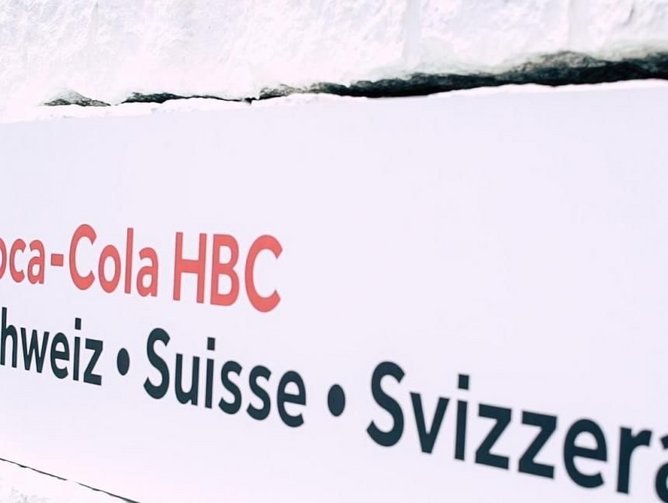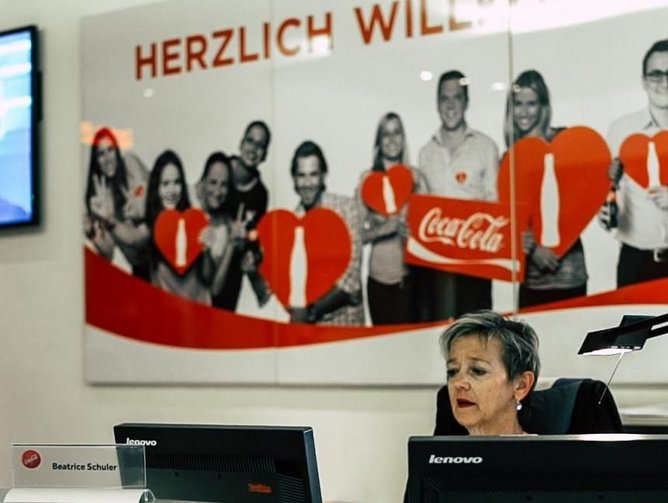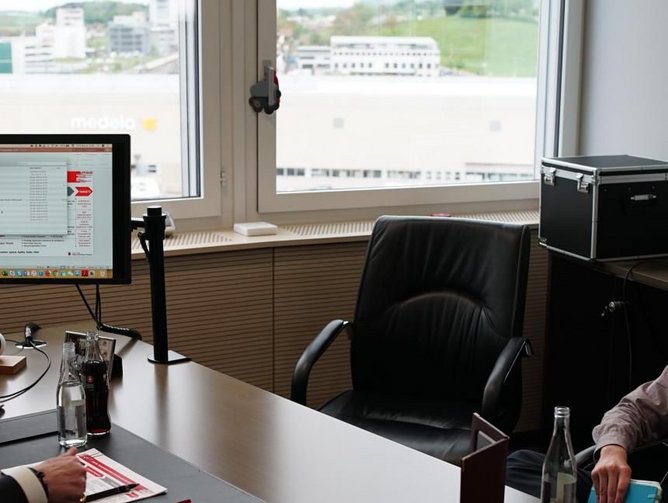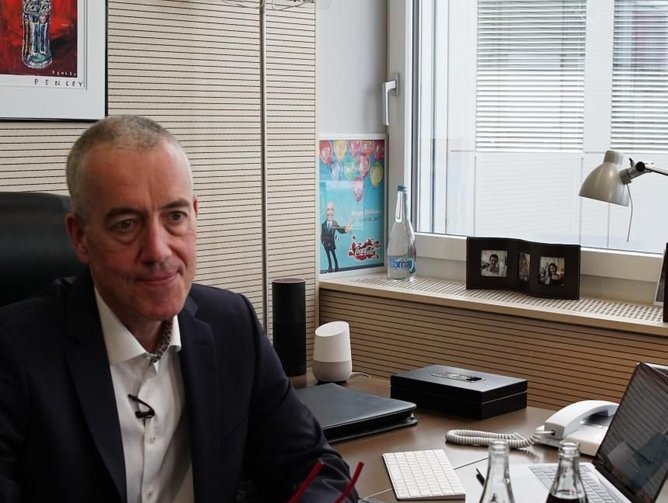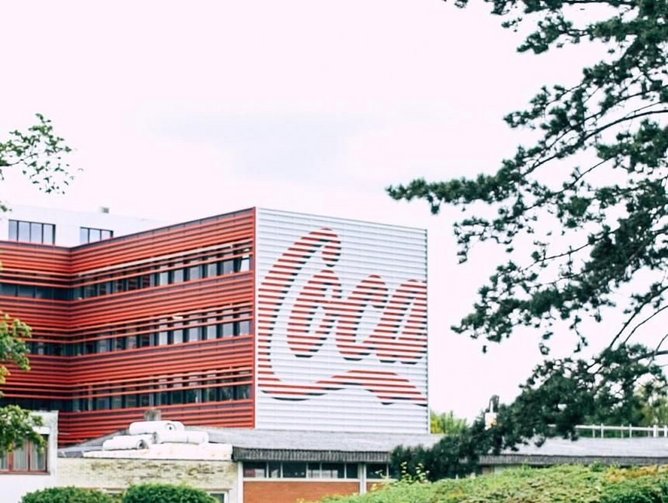Coca-Cola Hellenic Bottling Company is connecting consumers whilst driving top line growth through digital transformation
Coca-Cola Hellenic Bottling Company (CCHBC), beverage giant Coca-Cola’s largest bottler in Europe, has made great strides in its digital transformation journey since we sat down with the business in January 2018. “Two things that have happened over the past 12 to 18 months are acceleration and fine-tuning,” says Group CIO Alain Brouhard at CCHBC’s corporate headquarters in Zug, Switzerland. A consummate professional with an active role at both Gartner and Singularity University, Brouhard has been leading CCHBC’s digital transformation as Group CIO for the past three years. The key advancements of the journey since we last spoke are encapsulated in the expanded deployment of its innovative smart cooler fleet as well as continual, data-driven revolutions of efficiency in both its internal operations and relationships with vendors and consumers. “Digital transformation, for us, is to drive the top-line growth as well as the bottom-line through efficiency and cost leadership: one of the most critical elements of that is in connecting experiences between our customers, our consumers and our business developers.”
Connecting the experience
The aforementioned smart coolers enable CCHBC to tick every box on this agenda. The beacon-enhanced coolers, which deliver push notifications to nearby consumers with special promotions, totalled around 120,000 in January 2018. That number has tripled in just over a year, and Brouhard affirms that CCHBC will have deployed 500,000 across its 28 operational markets by the end of 2019. “Our coolers talk to the consumer,” says Brouhard. “If you have a third-party smartphone app, such as ShopFully in Italy with whom we’re now live, a push notification is sent to your phone when you pass close to one of the coolers.” Not only does the push notification alert the consumer to the fact a cooler is nearby, it can also provide exclusive offers to encourage them to make a purchase. “This is an example of proximity marketing, and it’s elevating the performance of our promotions to a significantly better level: we have a return rate of promotion of 7-10% compared to traditional returns of 2-3%,” says Brouhard.
The impact that the coolers have through communicating directly with potential consumers is augmented with the data-driven efficiency they enable. “The cooler, just to make it clear, is not a vending machine,” clarifies Brouhard. “With a vending machine, you know exactly what has been bought and you have a record of each purchase. This device has an open door, and we don’t have a record of how many items or bottles have been sold from it. With the beacons we have put in place we can track how often the door opens, and we know that around 80% of door openings indicate a sale. We can therefore assess the performance of each cooler; by knowing the performance, we can improve the location of the product so, if it is not performing in a particular location, we can move it to somewhere where it might be more successful.” If a minor adjustment of placement is unsuccessful, CCHBC relocates the device entirely. “We move the cooler from a low-performing store to a high-performing one, and the impact of that is around a 12% increase in sales,” Brouhard enthuses.
Data-driven efficiency
Brouhard earmarks the company’s accelerated use of data-driven insights as another big step forward during the past year. “I believe the critical progress has been our focused and exponential deployment of Big Data and Advanced Analytics,” says Brouhard. The breadth of this advancement is significant, encompassing its segmented execution strategy, optimisation of its manufacturing processes and more. Segmented execution is the process in which Coca-Cola leverages data to ascertain the most effective manner to display its product range depending on the location, local demographics and the context of the store’s own layout. “In our pilot countries like Nigeria, we have put together a single data lake – powered by Microsoft Azure – to collate social media and internal customer data. We will be expanding soon our data sets with consumer household panel and weather data We are developing algorithms to autonomously analyse the data in this lake and assist us with better product segmentation at the point of sale,” Brouhard explains.
On the manufacturing side, Brouhard highlights CCHBC’s partnership with analytics specialist Trilobyte that is driving a new level of quality control. “One of the prerequisites of the manufacturing process is the quality standard,” says Brouhard, noting the importance of ensuring quality as it manufactures the full Coca-Cola product portfolio. “Trilobyte and French digital transformation expert Atos have contributed to developing our statistical process control tool. This has enabled us to analyse manufacturing data points to anticipate quality concerns and subsequently take actions for continuous improvement of our final product’s quality. We have been developing those insights across more of our manufacturing plants, and that’s something we will be reinforcing with additional technology in the future.”
The right partners
Trilobyte and Atos have not been the only key partners for CCHBC’s continued digital transformation efforts. Through its relationship with Microsoft, CCHBC is launching a unified communication platform, Microsoft Teams, that will radically upgrade a range of processes deep within the organisation. “We are deploying Microsoft Teams extremely rapidly to enhance Office365 and to replace Skype for Business. We have found the platform to be extremely efficient and viable for enhancing collaboration within teams at every level of the organisation. We are even using Teams as one of the ways to communicate and collaborate among the Executive Committee,” says Brouhard. Elsewhere, CCHBC’s historic relationship with SAP has continued to deepen. “Over the next three years we are progressively migrating to S/4HANA,” explains Brouhard. “We have already completed the migration of our business warehouse to SAP BW on HANA, and we’re now progressively moving more of our functionalities and applications over to in-memory processing.” Brouhard highlights the increased agility, simplicity and reliability afforded by S/4HANA as being the key factors driving the move, fostering an advancement of the Agile methodology that CCHBC has been ingraining into its operations. Atos is facilitating the transition to S4/HANA, joining with the work of CCHBC’s application maintenance support partner based in Sofia, Bulgaria.
CCHBC has also expanded its relationship with Greek telecommunications leader OTE, a Deutsche Telekom subsidiary. “We have a long-term contract with OTE as the provider of our main Private Cloud for all our businesses across the 28 countries,” says Brouhard. “They are also becoming our strategic partner for helpdesk both on and off-site, and that also complements our strategic partnership with them.” A striking new aspect of this relationship is in OTE’s fresh support for CCHBC’s cybersecurity practices. The firm has now signed a contract with CCHBC to manage its Security Operations Centre (SOC), providing around the clock log monitoring for each of the company’s 28 operational countries.
Battling cybercrime
“Our work with OTE is complementing our whole cyber infrastructure,” says Brouhard as he details the success CCHBC has enjoyed in the acceleration of its cybersecurity methodologies and technologies. The SOC, he says, enables the company to monitor IT and OT (operational technology) devices across its network, with algorithmic checks notifying the security team of any deviation that could signal a threat. “We have been able to stop viruses from spreading through the operation with the SOC’s work. An example would be in a dormant computer that had a virus, and when the computer was reactivated it was immediately picked up and isolated by the SOC to prevent the virus’s expansion. That single log, out of millions of logs that the SOC scans every day, prevented us from potentially experiencing significant issues.”
CCHBC has also risen to the task set by the European Union’s new GDPR legislation, appointing a Chief Information Security Officer (CISO) in the wake of concerns across the tech world of increased risk to consumer and enterprise data. “We built a new team because we needed to increase our knowledge and capability internally,” Brouhard says of the journey that led to the appointment of CCHBC’s first CISO. “A fundamental piece of work through 2018 had to do with GDPR, and I believe we are happy to announce that we have achieved GDPR compliance.” Brouhard is quick to add that both he and the company remain vigilant in all aspects of cybersecurity, noting that overconfidence is not a wise route to take with such risks. Part of the continued efforts to instil a strong security ethos within the company comes down to appreciating that individuals can pose the biggest risk to a company’s data security, and that education in this area is absolutely vital. “One of the elements I want to highlight is an awareness campaign that’s based on thinking before clicking,” says Brouhard. “The campaign pushes the whole idea of protecting our cyber environments by equipping the user at the forefront of the protection with the skills and awareness that they need.”
Driving future success
CCHBC’s digital transformation journey is set to continue for the foreseeable future, but Brouhard stresses the importance of the company seizing upon the opportunities presented by the technologies and solutions it has implemented thus far. “Before engaging with more technological challenges and opportunities, I want to make sure that we are properly deploying and using what we have in place,” he says, adding that maintaining the right pace is vital to effective change management. “The connected coolers are a good example: by the end of the year we will have deployed 500,000 coolers, and the ultimate goal is to have a fully connected fleet of 1.2mn.” Of technologies beyond those already engaged at CCHBC, Brouhard is excited by the potential of 5G and the continued development of Internet of Things (IoT) solutions. “Within the next one or two years we want to continue the transformation by using what I call ‘exponential technologies’. I see a huge opportunity to leverage IoT as we move into 5G technology, and we are planning to pilot some solutions of this kind with network companies. Voice recognition is another thing that we want to leverage internally and externally with our consumers in some form.” The third technology in Brouhard’s sights is blockchain, which CCHBC is currently piloting for use in supply chain management. “We want to be able to communicate and provide supply chain visibility to the end consumer,” he says.
The critical element to CCHBC’s entire journey is the focus on driving top-line growth through technology, never forgetting the importance of remaining cautious to the risks that such technologies can pose. “We know that cybercrime is out there,” concludes Brouhard, “and what I believe to be absolutely critical is that, when we leverage and enhance these technologies, we need to be very vigilant to the fact that we are opening the door to increased risk.” CCHBC’s laudable advancements with digital transformation are certainly compounded by this awareness, as both Brouhard’s and the company’s tireless focus on cybersecurity ensures it is ready for anything.
